

Lexophiles. LEXOPHILES (LOVERS OF WORDS): 1.
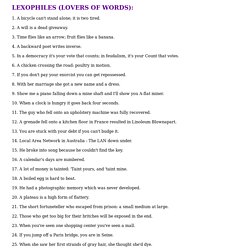
A bicycle can't stand alone; it is two tired. 2. A will is a dead giveaway. 3. Time flies like an arrow; fruit flies like a banana. 4. 5. 6. 7. 8. 9. [GMAIL] - [PHP] - Send email using PHP with Gmail. Code Examples -> Human readable PHP password generator. Webdesign. OFBiz, The Apache Open For Business Project - Open Source E-Business / E-Commerce, ERP, CRM, POS. TEDMED. Purist Product Management. How To Be A Good Product Manager: Product management tips. Product Management. Mylow Magnetic Motor Debunked: NSA Involved – It Can’t Be Fake. Many DIY-pseudo-scientists have tried to build magnetic motors themselves, and it’s said some of them may have even succeeded, but there is no practical evidence of their success.
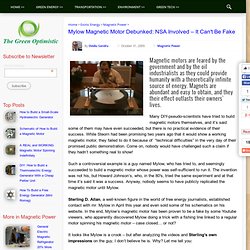
While Steorn had been promising two years ago that it would show a working magnetic motor, they failed to do it because of “technical difficulties” in the very day of their promised public demonstration. Bitter electromagnet. Advantages[edit] Bitter electromagnets are used where extremely strong fields are required.
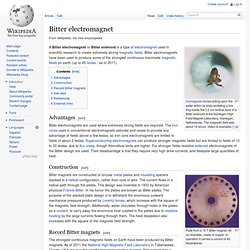
The iron cores used in conventional electromagnets saturate and cease to provide any advantage at fields above a few teslas, so iron core electromagnets are limited to fields of about 2 teslas. Superconducting electromagnets can produce stronger magnetic fields but are limited to fields of 10 to 20 teslas, due to flux creep, though theoretical limits are higher.
For stronger fields resistive solenoid electromagnets of the Bitter design are used. Their disadvantage is that they require very high drive currents, and dissipate large quantities of heat. Construction[edit] Solenoid. An illustration of a solenoid A solenoid (from the French solénoïde, derived in turn from the Greek solen "pipe, channel" + combining form of Greek eidos "form, shape"[1]) is a coil wound into a tightly packed helix. The term was invented by French physicist André-Marie Ampère to designate a helical coil.[2] In physics, the term refers specifically to a long, thin loop of wire, often wrapped around a metallic core, which produces a uniform magnetic field in a volume of space (where some experiment might be carried out) when an electric current is passed through it. A solenoid is a type of electromagnet when the purpose is to generate a controlled magnetic field.
If the purpose of the solenoid is instead to dampen changes in the electric current, a solenoid can be more specifically classified as an inductor rather than an electromagnet. In engineering, the term may also refer to a variety of transducer devices that convert energy into linear motion. Infinite continuous solenoids[edit] What can increase the magnetism in an elctromagnet? - Yahoo! Ans. Variable field magnet apparatus - Google Patents. This invention relates in general to the field of magnetic devices, and more particularly, to an apparatus and method for producing with permanent magnets a varying magnetic field, such as for example, a magnetic field as used in semiconductor processing.
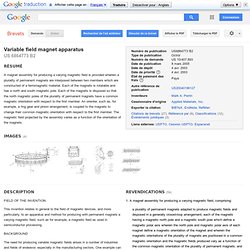
The need for producing variable magnetic fields arises in a number of industries and fields of endeavor, especially in the manufacturing sectors. One example can be found in the semiconductor processing industry. Magnetic and Gravity Dynamics. Patente US20060075683 - Apparatus and method for the conversion of water into a new gaseous and ... - Google Patentes. This patent application is a divisional application of U.S. patent application Ser.
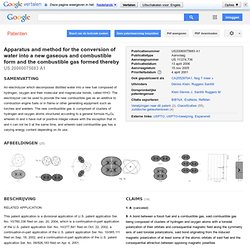
No. 10/760,336 filed on Jan. 20, 2004, which is a continuation-in-part application of the U.S. patent application Ser. HHO energy. GEET International Institute Educational Website. Perendev is Tooling Up for Magnetic Motor Mass Production in Europe. All-magnet motor poised to be first to reach market.
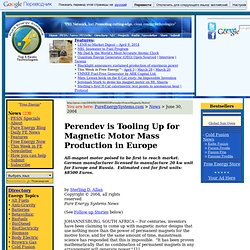
German manufacturer licensed to manufacture 20 kw unit for Europe and Russia. Estimated cost for first units: $8500 Euros. by Sterling D. Allan Copyright © 2004, all rights reserved Pure Energy Systems News (See Follow-up Stories below) JOHANNESBURG, SOUTH AFRICA -- For centuries, inventors have been claiming to come up with magnetic motor designs that use nothing more than the power of permanent magnets for the motive force; and for the same amount of time, mainstream science has responded that this is impossible. History tells us that what has been proven in many people's back yards and garages does not always coincide with mathematics of the day. Student Creates Electromagnetic Harvester That Gathers Free Electricity From Thin Air. A German student has built an electromagnetic harvester that recharges an AA battery by soaking up ambient, environmental radiation.

These harvesters can gather free electricity from just about anything, including overhead power lines, coffee machines, refrigerators, or even the emissions from your WiFi router or smartphone. This might sound a bit like hocus-pocus pseudoscience, but the underlying science is actually surprisingly sound. We are, after all, just talking about wireless power transfer — just like the smartphones that are starting to ship with wireless charging tech, and the accompanying charging pads. How the Technology Works - algae to biofuels. OMEGA Project. <center><div class="site_errors"><div class="floatType_site_error_top"></div><div class="floatType_site_error"><table summary="layout table"><tr><td bgcolor="#000000"><font color="#ffffff"><h2><img src="/templateimages/redesign/modules/overlay/site_error.gif" title="Site Error" alt="Site Error"/>There's a problem with your browser or settings.
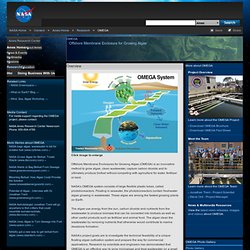
</h2></font><font color="#ffffff"><p>Your browser or your browser's settings are not supported. To get the best experience possible, please download a compatible browser. If you know your browser is up to date, you should check to ensure that javascript is enabled. Nanotubes boost potential of salinity power as a renewable energy source.
In November 2009, Norwegian state owned electricity company Statkraft opened the world’s first osmotic power plant prototype, which generates electricity from the difference in the salt concentration between river water and sea water.
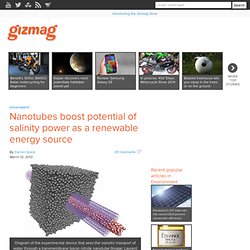
While osmotic power is a clean, renewable energy source, its commercial use has been limited due to the low generating capacities offered by current technology – the Statkraft plant, for example, has a capacity of about 4 kW. Now researchers have discovered a new way to harness osmotic power that they claim would enable a 1 m2 (10.7 sq. ft.) membrane to have the same 4 kW capacity as the entire Statkraft plant. The global osmotic, or salinity gradient, power capacity, which is concentrated at the mouths of rivers, is estimated by Statkraft to be in the region of 1,600 to 1,700 TWh annually. Hydrogen - Nature's Fuel. Hydrogen Fuel Cell. Wave-energy.